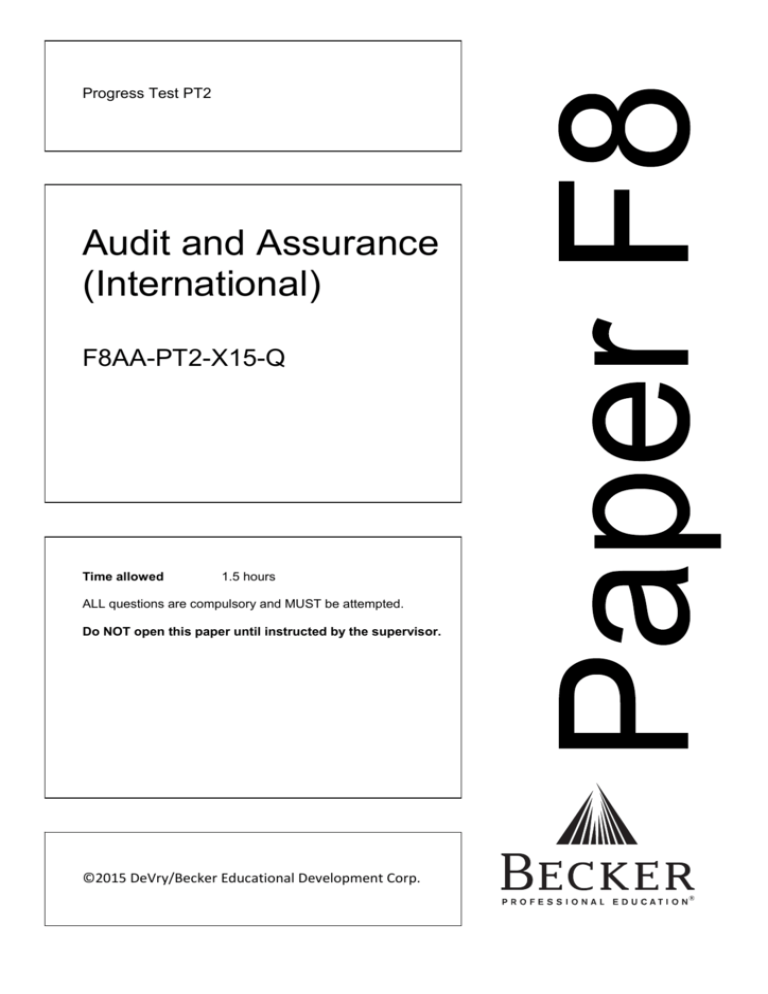
Progress Test PT2
Audit and Assurance
(International)
F8AA-PT2-X15-Q
Time allowed
1.5 hours
ALL questions are compulsory and MUST be attempted.
Do NOT open this paper until instructed by the supervisor.
©2015 DeVry/Becker Educational Development Corp. ®
ALL questions MUST be answered
1
Olga, a partner in Hugh Transit & Co, a firm of Chartered Certified Accountants, is the
engagement partner on the audit of Drinks & Bevs PLC, a listed company. She is reviewing
the audit file for the year ended 31 August 2014.
In the close down section of the audit file is a memo from the audit manager recommending
the issue of a qualified audit opinion. Drinks & Bevs’s major customer, a chain of small
convenience stores, is known to be in financial difficulties yet no allowance has been made
against the material debt owed to Drinks & Bevs’. The finance director is arguing that the
customer has agreed in principle to sell the stores and is just waiting for the new buyer to
confirm the agreement of sale. Once the customer has the money, it will be in a position to
repay all debts, including that owed to Drinks & Bevs. He claims to have consulted another
firm of certified chartered accountants who have indicated that an allowance (right down) of
the debt is not necessary. Olga is unhappy with the situation for the following reasons:
(a)
She is reasonably certain that, if she issues a qualified opinion, the directors of
Drinks & Bevs will recommend appointment of another firm as auditor and the
finance director appears to be already ‘opinion shopping’.
(b)
Her firm supplies many other non-audit services to Drinks & Bevs such as
preparing tax returns and management consultancy which bring in twice as much
revenue as the audit and are more profitable. It is highly unlikely the firm would
continue to be asked to provide these services if the audit is lost. In total, fees paid
by Drinks & Bev for the audit and these other services amount to 8% of the audit
firm’s revenues.
(c)
She has been the engagement partner for three years and is certain that the finance
director has always been truthful with her in the past. However, the evidence in the
audit file is quite persuasive that the customer is in financial difficulty and if the
sale of the stores does not materialise it will be unable to pay the debts.
She calls the finance director to advise him that she will have no choice but to give a qualified
opinion if the financial statements do not contain a write down of the debt to its recoverable
amount, which will probably be zero.
Required:
(a)
Describe actions that auditors can take when being threatened with removal by
the directors.
(5 marks)
(b)
Explain how obtaining a second opinion differs to “opinion shopping”.
(3 marks)
(c)
State, giving examples, the requirements of ethical and corporate governance
standards relating to the supply of non-audit services to publicly listed
companies.
(10 marks)
(18 marks)
©2015 DeVry/Becker Educational Development Corp. All rights reserved.
2
2
Audit rotation is considered to be an appropriate safeguard for auditor independence.
Required:
Explain the term “rotation” as it applies to auditors.
3
(5 marks)
The preparation of working papers is an important part of the audit process. You have been
asked to prepare a session introducing new recruits to your firm of Chartered Certified
Accountants to the use of working papers. Two of the topics you have been asked to cover
are:
(a)
(b)
the design and use of audit programmes; and
the concept of an audit trail with respect to the conduct of the audit itself.
Required:
(a)
Explain the design and use of audit programmes and discuss the merits of
standard and tailored audit programmes.
(7 marks)
(b)
Explain the importance of recording details of the actual evidence examined in
the course of the audit on which the conclusions are drawn. Your answer
should include consideration of the details of evidence to be recorded in the
working papers and of the audit trail to be left in the books and records of the
entity being audited.
(8 marks)
(15 marks)
4
There are similarities and differences between the responsibilities of internal and external
auditors. Both internal and external auditors have responsibilities relating to the prevention,
detection and reporting of fraud, for example, but their responsibilities are not the same. Both
internal and external audit are part of an organisation’s overall corporate governance
arrangements. Sometimes, the responsibilities of internal auditors are out-sourced to external
organisations.
Required:
(a)
Explain the difference between the responsibilities of internal auditors and
external auditors for the prevention, detection and reporting of fraud and
error.
(7 marks)
(b)
Outline the issues that should be considered when an organisation decides to
out-source the internal audit function.
(5 marks)
(12 marks)
End of Question Paper
©2015 DeVry/Becker Educational Development Corp. All rights reserved.
3








